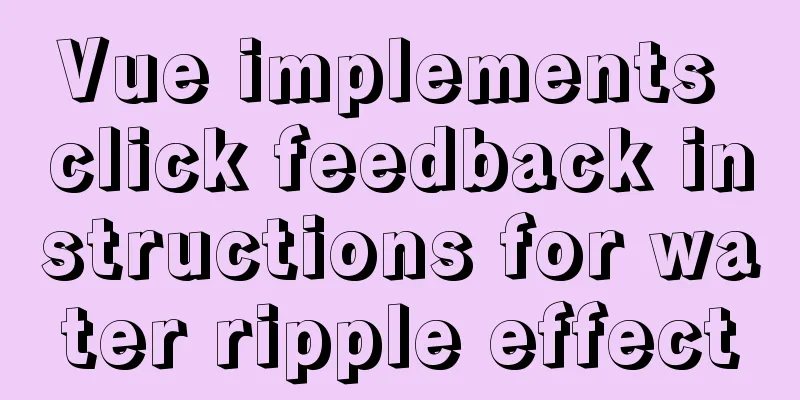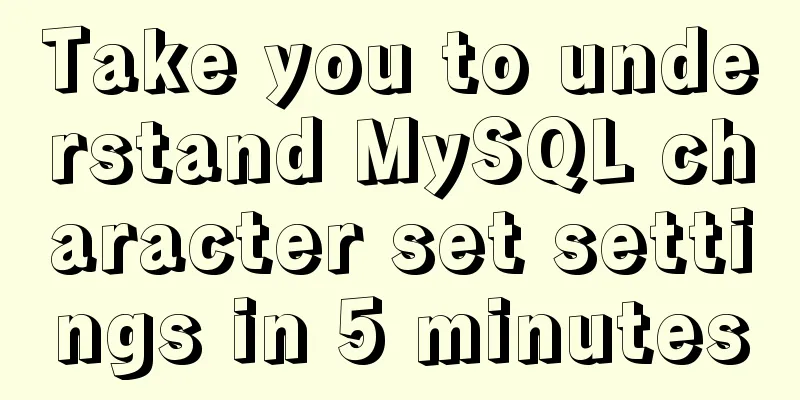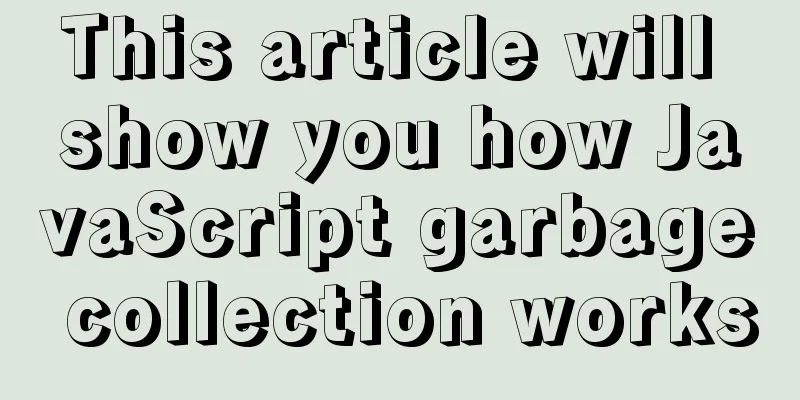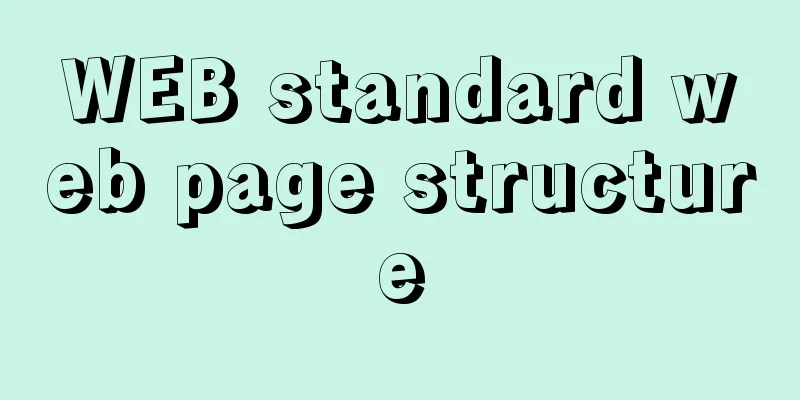Vue implements click feedback instructions for water ripple effect

Water wave effectWhen the user clicks, a ripple effect will be generated with the center of the click as the center. It is suitable for various scenes, beautiful without being exaggerated, and the key is that it can provide very intuitive feedback to the user.
Let's see the implementationFirst of all, the encapsulation here is based on Vue3 custom instructions. The custom instructions of Vue3 have not changed much compared with Vue2. Our goal is to complete a basic prototype of the water wave command, and here we proceed step by step. Customize a water ripple default styleWater ripples are actually a process in which a small circle is generated at the location where the user clicks, and the size gradually expands to the entire clicked element. So here we first formulate a basic style of water waves and set up transition animations. The transition animation should be a process that starts slow and then speeds up. Here we use Bezier curve customization
.my-ripple {
position: absolute;
top: 0;
left: 0;
z-index: 100;
border-radius: 50%;
background-color: currentColor;
opacity: 0;
transition: transform 0.2s cubic-bezier(0.68, 0.01, 0.62, 0.6), opacity 0.08s linear;
will-change: transform, opacity;
pointer-events: none;
}
Calculate the position and diameter of water ripplesIf we determine the diameter of the water wave, the (x, y) when it is created, and the (x, y) when the transition animation ends, we can use transition to render the water wave animation. The (x, y) when it is created is the position where the user clicks, but how do we calculate the diameter of the water wave and the (x, y) when the transition animation ends? Our elements are all rectangles. No matter where the user clicks on the element, the circle with the hypotenuse of the rectangle as its diameter can perfectly cover the entire element. To calculate the hypotenuse, we use elementary school math knowledge to find the square root of the sum of the squares of both sides. The following is a water wave deduction diagram at the end of the transition animation. First arrow: Expected water wave Second arrow: Water wave created at element (0,0) Third arrow: Water wave created at element (0,0) without rounded corners
We can find that by offsetting the water wave created by the element (0,0) point, we can get the water wave we want, from which we can infer that The size of the water wave at the end of the animation = The (x,y) of the hypotenuse of the circle when it is created = The position where the user clicks The (x,y) at the end of the transition animation = The water wave created at the element (0,0) is offset by x and y
function computeRippleStyles(element, event) {
const { top, left } = element.getBoundingClientRect()
const { clientWidth, clientHeight } = element
const radius = Math.sqrt(clientWidth ** 2 + clientHeight ** 2) / 2
const size = radius * 2
const localX = event.clientX - left
const localY = event.clientY - top
const centerX = (clientWidth - radius * 2) / 2
const centerY = (clientHeight - radius * 2) / 2
const x = localX - radius
const y = localY - radius
return { x, y, centerX, centerY, size }
}
Create water waves when the mouse is pressedThen we need to create water waves when the mouse is pressed and listen for the mouse press event. Here we take the PC side as an example. When the water waves are just created, use transform to shrink them to 0.3. This is a relatively suitable creation size that the author has tried. Then modify transform to trigger the transition water wave diffusion animation. Transparency transition is also added here to make the water wave ripples more textured.
function createRipple(event) {
const container = this
const { x, y, centerX, centerY, size } = computeRippleStyles(container, event)
const ripple = document.createElement('div')
ripple.classList.add('my-ripple')
ripple.style.opacity = `0`
ripple.style.transform = `translate(${x}px, ${y}px) scale3d(.3, .3, .3)`
ripple.style.width = `${size}px`
ripple.style.height = `${size}px`
// Record the creation time of the water wave ripple.dataset.createdAt = String(performance.now())
const { position } = window.getComputedStyle(container)
container.style.overflow = 'hidden'
position === 'static' && (this.style.position = 'relative')
container.appendChild(ripple)
window.setTimeout(() => {
ripple.style.transform = `translate(${centerX}px, ${centerY}px) scale3d(1, 1, 1)`
ripple.style.opacity = `.25`
})
}
const VRipple = {
mounted(el) {
el.addEventListener('mousedown', createRipple)
}
}
Destroy the water wave when the mouse is liftedWhen the mouse is lifted, you only need to find the generated water wave node to modify the transparency, and then remove the water ripple node after the transparency modification animation ends.
function removeRipple() {
const container = this
const ripples = container.querySelectorAll('.my-ripple')
if (!ripples.length) {
return
}
const lastRipple = ripples[ripples.length - 1]
// Calculate how long the diffusion animation will take to execute based on the creation time of the water wave to ensure that each water wave completes the diffusion animation const delay = 300 - performance.now() + Number(lastRipple.dataset.createdAt)
setTimeout(() => {
lastRipple.style.opacity = `0`
setTimeout(() => lastRipple.parentNode?.removeChild(lastRipple), 300)
}, delay)
}
const VRipple = {
mounted(el) {
el.addEventListener('mousedown', createRipple)
document.addEventListener('mouseup', removeRipple)
},
unmounted(el) {
el.removeEventListener('mousedown', createRipple)
document.removeEventListener('mouseup', removeRipple)
}
}
Expand your water wave options with command bindingYou can also extend your instructions through binding, for example, you can provide options for changing color, disabling status, etc., which I will not go into detail here. Let’s take a look at the results.
Final ThoughtsSo far we have implemented a simple ripple instruction. There is also such an instruction in our component library, so you can go to our source code for a more complete version. First of all, I would like to thank the Nuggets community. Some of the friends have already started to PR some codes to our warehouse. We are also very happy to do such a thing with the friends in the community. In addition, our component library team has been recruiting enthusiasts to participate in the contribution. Friends who are interested are welcome to join the discussion. The way to join is to go directly to the warehouse to raise an issue and leave an email. We will deal with it as soon as possible. Whether you are interested or not, I hope you can give us a star and pay attention to us. The support and interest of community partners are our greatest motivation. Warehouse Address Document Address The above is the details of the click feedback instruction of Vue to achieve the water ripple effect. For more information about the click feedback instruction of Vue, please pay attention to other related articles on 123WORDPRESS.COM! You may also be interested in:
|
<<: MySQL 8.0.13 installation and configuration tutorial under CentOS7.3
>>: How to output Chinese characters in Linux kernel
Recommend
How to use Lottie animation in React Native project
Lottie is an open source animation library for iO...
mysql executes sql file and reports error Error: Unknown storage engine'InnoDB' solution
Find the problem I recently encountered a problem...
Alpine Docker image font problem solving operations
1. Run fonts, open the font folder, and find the ...
Will this SQL writing method really cause the index to fail?
Preface There are often some articles on the Inte...
Master-slave synchronization configuration and read-write separation of MySQL database
The benefits of using MySQL master-slave replicat...
MySQL log system detailed information sharing
Anyone who has worked on a large system knows tha...
MySQL PXC builds a new node with only IST transmission (recommended)
Demand scenario: The existing PXC environment has...
ERROR 1045 (28000): Access denied for user ''root''@''localhost'' (using password: YES) Practical solution
There was no problem connecting to the database y...
How to build SFTP server and image server on Linux cloud server
First of all, you can understand the difference b...
Creating Responsive Emails with Vue.js and MJML
MJML is a modern email tool that enables develope...
Sample code using the element calendar component in Vue
First look at the effect diagram: The complete co...
JavaScript Basics Operators
Table of contents 1. Operators Summarize 1. Opera...
How to deploy stand-alone Pulsar and clustered Redis using Docker (development artifact)
Table of contents 1. Introduction: 2. Docker: 1 C...
12 Javascript table controls (DataGrid) are sorted out
When the DataSource property of a DataGrid control...
Install mysql5.7 on Ubuntu 18.04
Ubuntu 18.04 installs mysql 5.7 for your referenc...













